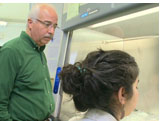The Verakin High School of Chongqing, China reports that they used MIT BLOSSOMS lessons during this past academic year to teach 22 advanced students in their Senior 1 group. Because the teaching philosophy of BLOSSOMS is quite novel and different from that of the traditional Chinese way, officials hope that these lessons will help change the school’s style of teaching and learning. Although English vocabulary was sometimes a challenge, participating students really liked the problem-solving focus of the BLOSSOMS lessons and also the way these lessons connected topics studied with real-life applications. Additional Verakin teachers are being trained in BLOSSOMS for the next academic year “so that more students can be involved in such courses to stimulate their creativity.” The number of participating students will be doubled to 44 this coming year.
 BLOSSOMS is pleased to announce the arrival of a lesson to introduce students who are interested in human biology and biochemistry to the subtleties of energy metabolism through the lens of ATP (adenosine triphosphate) as the primary energy currency of the cell. Avoiding details of the major pathways of energy production—such as glycolysis, the citric acid cycle, and oxidative phosphorylation—this lesson is focused exclusively on ATP, which is truly the fuel of life. The lesson is taught by Dr. Christian Schubert, Head Teaching Fellow, Neurobiology of Behavior at Harvard University and Manager, PharmaTherapeutics Precision Medicine at Pfizer. Watch it here. BLOSSOMS is pleased to announce the arrival of a lesson to introduce students who are interested in human biology and biochemistry to the subtleties of energy metabolism through the lens of ATP (adenosine triphosphate) as the primary energy currency of the cell. Avoiding details of the major pathways of energy production—such as glycolysis, the citric acid cycle, and oxidative phosphorylation—this lesson is focused exclusively on ATP, which is truly the fuel of life. The lesson is taught by Dr. Christian Schubert, Head Teaching Fellow, Neurobiology of Behavior at Harvard University and Manager, PharmaTherapeutics Precision Medicine at Pfizer. Watch it here.
 A second BLOSSOMS lesson from the American University of Beirut (AUB) aims to help students conceptualize the fact that although all cells in the animal or human body contain the same DNA, different cells in different tissues express, on the one hand, a set of common genes, and on the other, another set of genes that vary depending on the type of tissue and the stage of development. In this video lesson, students will be reminded that genes in a cell/tissue are expressed when certain conditions in the nucleus are met. Among other factors—all discussed fully in the lesson—cells make use of a tiny scaffold known as the “Nuclear Matrix or Nucleo-Skeleton.” This lesson is taught by Dr. Rabih Talhouk, a Professor of Cell Biology at AUB and by Elia El-Habre, MSc. of the Biology Department at AUB. View here. A second BLOSSOMS lesson from the American University of Beirut (AUB) aims to help students conceptualize the fact that although all cells in the animal or human body contain the same DNA, different cells in different tissues express, on the one hand, a set of common genes, and on the other, another set of genes that vary depending on the type of tissue and the stage of development. In this video lesson, students will be reminded that genes in a cell/tissue are expressed when certain conditions in the nucleus are met. Among other factors—all discussed fully in the lesson—cells make use of a tiny scaffold known as the “Nuclear Matrix or Nucleo-Skeleton.” This lesson is taught by Dr. Rabih Talhouk, a Professor of Cell Biology at AUB and by Elia El-Habre, MSc. of the Biology Department at AUB. View here.
 BLOSSOMS will soon be available in another language: Portuguese. We are happy to announce that our Brazilian partner, Canal Futura, Brazil's largest educational television network http://www.futura.org.br/, has now completed the translation of 37 BLOSSOMS modules into Portuguese, using subtitles. This adds a fourth language to BLOSSOMS: Portuguese, in addition to English, Arabic and Urdu. Canal Futura plans to air these translated BLOSSOMS modules multiple times over their extended network, which reaches 35 million Brazilians. The selected 37 modules were drawn from the set of modules that we had available as of May 2011. We are hopeful that as the joint partnership evolves and grows, additional modules that have been created during the last 15 months will also be translated. Our plan is to post these Portuguese subtitled versions on the MIT BLOSSOMS web site in August. BLOSSOMS will soon be available in another language: Portuguese. We are happy to announce that our Brazilian partner, Canal Futura, Brazil's largest educational television network http://www.futura.org.br/, has now completed the translation of 37 BLOSSOMS modules into Portuguese, using subtitles. This adds a fourth language to BLOSSOMS: Portuguese, in addition to English, Arabic and Urdu. Canal Futura plans to air these translated BLOSSOMS modules multiple times over their extended network, which reaches 35 million Brazilians. The selected 37 modules were drawn from the set of modules that we had available as of May 2011. We are hopeful that as the joint partnership evolves and grows, additional modules that have been created during the last 15 months will also be translated. Our plan is to post these Portuguese subtitled versions on the MIT BLOSSOMS web site in August.
|